Mott, Pell, and Bayard were the original three streets
that formed the core of Chinatown in the mid to late 1800s.
| |
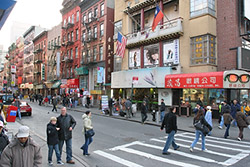
|
03 Jan 2007. Corner of Mott and Canal St. |
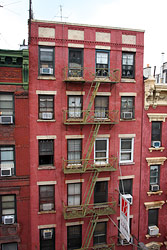
|
25 August 2008. 65 Mott St. Built in 1824, this was the first building constructed specifically as a tenement. Buildings such as this one later symbolized the evils of the tenement system with its crowded, and airless living spaces; and apartments that became fire and health hazards.
In 1869, 1879, and 1901, NYC passed several laws regulating what a tenement house must have, namely fire escapes, windows for fresh air and sunlight, a courtyard, and flush toilets. [FN 1, 2] |
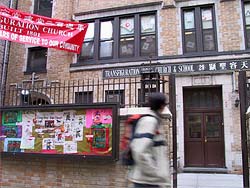
|
21 Feb 2002. Transfiguration Church and
School, 29 Mott Street. On Saturdays, there is non-religious Chinese school. |
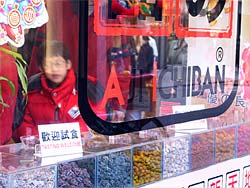
|
21 Feb 2002. Treats at Aji Ichiban, a Hong Kong based candy
store. 37 Mott Street.
Candied fruit, preserved plums, and dried squid
are just some of the treats one will find here in addition to chocolates, and candy. |
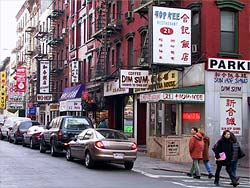 |
25 Feb 2002. Mott St. restaurants.
Mott Street really took off as a tourist destination in the late 1800s when
the first Chinese restaurants began appearing near Chatham Square, and people
wanted to go "slumming" in places such as Chinatown.
View this intersection in an old photo,
by Byron, circa 1900, when an American Express office occupied the corner. |

|
21 April 2007. Peking Duck at the Peking Duck House during "Taste of Chinatown", a biannual event with $1-2 food tastings from a variety of Chinatown restaurants.
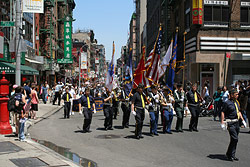
|
26 May 2008. American Legion.
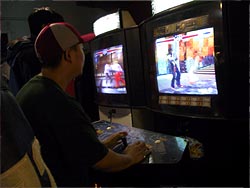
|
The local video arcade, Chinatown Fair, 8 Mott Street. |
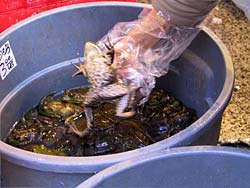
|
19 Feb 2002. Frogs at a fish stall on Mott Street between Grand and Hester Streets. |
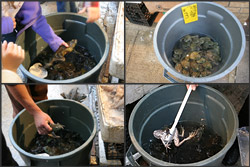
|
October 2006. A collection of frog photos: (top left) kids playing with a frog; (top right) bucket of frogs; (bottom left) bag of frogs; (bottom right) frog in a pair of tongs.
|
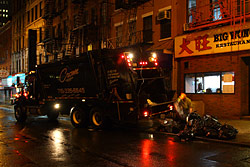
|
06 June 2009. Sanitation is important. Chinatown has a lot of restaurants, and all the garbage that is generated has to go somewhere, otherwise the neighborhood becomes a cesspool.
|
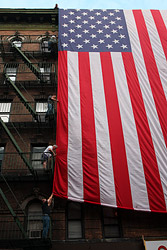
|
03 Sept 2009. Ground Zero flag.
The guy who takes care of the flag that flew over Ground Zero drapes it over his apartment building each year to mark the anniversary of September 11.
|
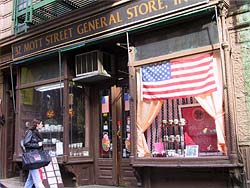
|
25 Feb 2002. 32 Mott Street is currently the oldest shop
in Chinatown established 1891. The store closed October 2003. |
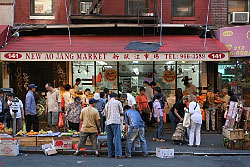
|
21 June 2006. End of day specials at a produce stand. Most shoppers are value-conscious, looking for the best quality produce possible at the lowest prices they can find. Some shoppers are price-conscious, sacrificing quality for cheaper prices.
|
| | |
NYC: Chinatown
by SoundWalk, 2003. Audio CD, 55 minutes.




"...If you can't make the trek to New York City, this is the closest you can come to first-hand experience of the sights, sounds, and personalities of the Lower East Side... Guided by a local personality, packed full of interviews, insights, recollections, and cinematic sound effects... This walking tour gives you the inside scoop on Chinatown's opium dens, sweatshops, Buddhist Temples, Chinese Mobsters, and more."
--publisher's summary
Find more recommended titles in the bookstore.
Footnote 1:
Tenement houses first sprung up around the early 1800s in answer to New York's
housing shortage. They were cheap to build, and landlords often
maximized profits by packing as many people they can into one.
Living conditions, however, was extremely poor. Charitable organizations,
and the press cited the rampant overcrowding, poor sanitation, and the lack
of fresh air, sunlight, and heat circulating through buildings. Fire safety
was also a huge concern.
Even though a uniform building code was first adopted in 1867, which
required a window in every sleeping room, as well as privies in every tenement,
the laws were not fully enforced until 1901 when a new building code (the
"Tenement House Act"), along with an enforcement agency behind it, went into
effect. The new law virtually outlawed the construction of tenements by
requiring all buildings -- both new and old -- to have interior flush toilets,
a fire escape, and ventilation shafts for both air, and light. Forced to abide
by the new laws, many landlords began adopting the "dumbbell" design type of
tenement where there is a small narrow airshaft in the back of the building
providing the legal window, air, and sunlight to all its residents.
In 1935, passage of the "Multiple dwelling act" not only improved
fire safety, and ventilation in the building, but also required flush toilets
in every apartment, not just a toilet per floor which was the case in many
buildings. Buildings today are still classified according to
whether or not it is an old law tenement (built before 1901), or new law
(built after 1901), but regardless, they all must meet today's building codes.
Other sources:
FYI: Monument to the Slum, January 27, 2002, New York Times
http://query.nytimes.com/gst/fullpage.html?res=9B00E1D9163AF934A15752C0A9649C8B63
The Tenement As History And Housing
http://www.thirteen.org/tenement/eagle.html
Old Law Tenement, wikipedia.
http://en.wikipedia.org/wiki/Old_Law_Tenement
Footnote 2:
Anbinder, Tyler, "Five Points" pp 80-82.
Mott St New York Chinatown NYC Mott Street NY Manhattan map visitor maps tourist info information 紐約 中華街, 唐人街 ニューヨーク, チャイナタウン photo images photography photos Flushing Brooklyn china town pictures manhatan
|
|



